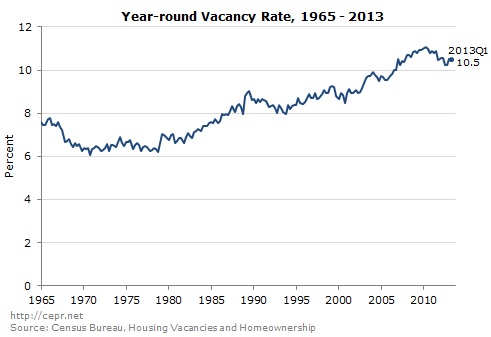Article
Fact-based, data-driven research and analysis to advance democratic debate on vital issues shaping people’s lives.
Center for Economic and Policy Research
1611 Connecticut Ave. NW
Suite 400
Washington, DC 20009
Tel: 202-293-5380
Fax: 202-588-1356
https://cepr.net
May 28, 2013 (Housing Market Monitor)
By Dean Baker
Prices for the bottom tier of Phoenix’s market have risen at a 47.0 percent annual rate over the last quarter.
The Case-Shiller 20-City Index rose by 1.1 percent in March, with all 20 cities again showing substantial gains. Prices are now up by 10.9 percent from their year ago levels, and have risen at a 14.9 percent annual rate in the last three months.
Detroit had the largest one month gain in March with prices rising 3.3 percent. However, most of the other big gainers were in the West. Prices in Las Vegas rose by 3.2 percent, while Los Angeles, Portland, San Francisco, and Seattle all had increases of 2.6 percent. Tampa had a price increase of 2.4 percent and Washington, DC had an increase of 2.3 percent. San Diego and Charlotte both had increases of 2.0 percent, rounding out the list of 2.0 percent gainers. New York again trailed the group with an increase of 0.4 percent. Prices in the New York area are up by just 2.6 percent over the last year.
The bottom tier of the market continues to drive price increases in most of these cities. While the rate of price increases in Phoenix moderated slightly to 1.8 percent in March, prices for homes in the bottom third of the market jumped by 4.3 percent. Over the last three months prices for homes in the bottom tier have risen at a 47.0 percent annual rate. They are up 39.7 percent over the last year.
Prices for homes in the bottom tier in Las Vegas rose by 4.8 percent in March. They have risen by 40.5 percent over the last year, albeit from very depressed levels. Prices for homes in the bottom tier in Atlanta rose by 4.5 percent. They are up 42.6 percent over the last year, also from very depressed levels. In Los Angeles and Miami prices in the bottom tier rose by 3.4 percent and are up 21.3 percent for the last year. In San Francisco price increases are more balanced, but the bottom end still has been rising most rapidly. Prices for homes in the bottom tier rose by 3.5 percent in March and have risen by 25.7 percent over the last year. This compares to a 22.2 percent increase for the market as a whole.
Residential construction fell sharply in April, dropping 16.5 percent from the March level, although starts were still up 13.1 percent from the year ago level. The South had the sharpest decline with starts down 27.9 percent in April, more than reversing a big jump in March. It is likely that this downturn simply reflects erratic data more than any real change in the pace of construction. Permits actually rose 14.3 percent in April with the South showing an even more rapid 16.0 percent rise. This sort of jump in permits is consistent with a plunge in starts. It is almost certainly the case that the drop was due to measurement issues.
It is worth noting that the nationwide vacancy rate continues to be well above normal, even as it drops from the record levels reached in the downturn. The year-round vacancy rate stood at 10.5 percent in the first quarter of 2013. This is down from a peak of more than 11.0 percent in 2010, but still well above the vacancy rate in the years before the bubble. The vacancy rate was under 9.0 percent in the 1990s and less than 8.0 percent in prior decades. The high level of vacancies will limit the pace at which prices rise and starts increase in many areas. If a normal rate of starts is in the range of 1.4-1.5 million units, the sector is not likely to reach this pace until at least 2015.
The rapid run up in prices in this report should raise real concerns. Nationwide prices are still in a range that is consistent with long-term trends and well below the peaks of the bubble. However the rapid rate of price increase at the bottom tier of many markets will push them into bubble territory if they continue much longer. While investors who are speculating in these markets may understand the risks, it is likely that many homeowners who buy into these bubbles will not.
